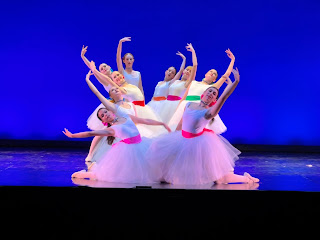Shadowing Day 2
Today I arrived at the dance costume shop and first thing I saw were these lovely colorful bows that Claire was working on.
Along with the bows that were being sewn and put together, they had to make two new tutu skirts for the performance, and that meant making two new waistbands from scratch for the tulle skirts that matched the color of the bows they made.
The waistband for the skirts were made previously, so in order for Jocelyn to make two more from scratch, she had to cut out the fabric and sew them together just by looking at the waistbands made already and figuring out the construction so she could replicate them.
In the apparel industry it can be super helpful to see things written out or more visual, and that was the case for Jocelyn when her and a teammate were figuring out how to construct the waistband for the two tutus.
This day of shadowing was a little extra fun because I was able to try out a couple of the industrial machines. They are known for moving a lot quicker than regular machines. The industrial machines are very necessary in the costuming department because they are whipping out sometimes nearly 50 different costumes within weeks. The first machine I tried out was the industrial serger. Below is the sample I produced.
The serger was pretty noisy but moved very fast and it felt very efficient trying it out. I then had the chance to use the industrial rolled hem machine. This machine uses a specific type of thread, it is stretchy. This allows the thread to wrap around the fabric without breaking and to give it a little more ease. But because this thread is a little thicker, it is a bit harder to thread. The team showed me how they use beeswax to smooth out and thin out the thread.
After they used the beeswax it was much easier to thread the stretchy thread through the needle.
Once we got things going, I noticed that the rolled hem machine was completely silent so much that you wouldn't know if it was on or not. It felt very smooth and quick and was really nice to use. Below is the sample I produced from this machine.
Both of these machines had two pedals unlike the regular machines. These industrial machines have the typical pedal for making the machine run, but they also have a pedal that lifts the presser foot. I thought this was very useful and would definitely help with the fast moving pace of the costume department. It keeps your hands more free and able to work with the fabric rather then worrying about the machine.
Something else really cool about the industrial machines, is that they have a sort of slide piece below the machine that allows the scraps that are cut off to fall down and right into the trash can. This is also very different from the regular machines, which the scraps just fall on the table and you have to remember to clear them off and throw them in the trash. This is much more efficient.
Meanwhile, Abby was sewing more rhinestones onto the last costume to go with the rest she was working on last week. She was using the same beeswax pen making the work more efficient.
Abby also told me about the specific costume she was gluing rhinestones onto. They had done a fitting previously and realized that in order to fit the dancer, the costume needed more room in the back. Because of this, Abby was able to add in panel to the back. This is just one example of repurposing costumes used in the past and making them fit and work for whatever project is taking place at the time.
Something else that was new to me in the costume shop, was that they use serger thread on all of the machines, not just the serger. They do this because they go through so much thread for their projects that it is just more efficient to use the serger thread spools, as they have much more thread per spool than a regular one. Because of this, they have what's called a spool stand that they prop the serger thread on and then thread it into the machine. The industrial machines do have a spot on them for a regular sized spool, they just don't use it.
As Jocelyn was making the waistbands for the two tutus, she realized she needed a specific measurement from the dancers which these waistbands were for. She needed to know where the tutu would hit their waist, because they used snaps on each side of the waist of the leotard underneath the tutus so they wouldn't fall as they danced.
This is something I would have never thought of. But in the dancing side of apparel, you have think about how the people wearing the apparel will be jumping and running and moving around a ton, and you don't want their costumes to malfunction. After going through all the other costumes to check who this specific tutu belonged to so she knew who they needed the measurements from, they realized there were two hair bows and one waistband bow that still needed to be made. This mistake came about because after a fitting earlier in the week, someone put the leotard of one of the dancers in the wrong place. This messed with the numbers they had record of, and thankfully was discovered and resolved.
By the end of the day I felt I had really seen more of some of the differences between the apparel I know and the costuming apparel they do here. The industrial machines, serger thread, fittings and figuring out costumes for multiple people was very different.


















Comments
Post a Comment